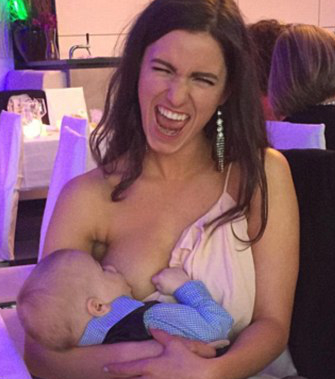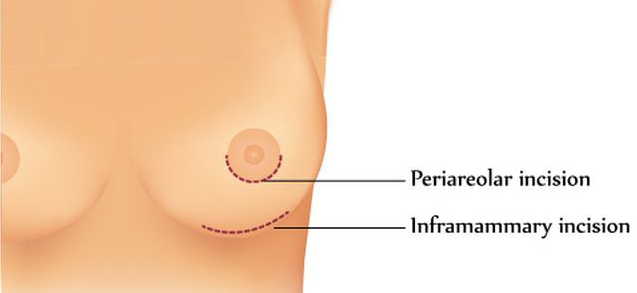
Breast feeding is good for babies nutritionally and emotionally. Above is Naomi Jael, from Germany. She caused a viral sensation this week with this snap of her breast feeding her 10-month-old son at a wedding reception, though comments centered more around her public display than the virtues of breast feeding.
A common question I get from women considering Breast Augmentation is, “Will Breast Implants interfere with Breastfeeding?” For women who are trying to reclaim their breasts after finishing having children, this is not an issue. However, if you want Breast Augmentation, and want to have children afterward, here are a few things you should know.
Is Silicone Safe For Babies?
Did you know that silicone drops are used to treat infant colic? An article from 1988, Mylicon drops in the treatment of infant colic, dosed 51 colicky infants with 0.3 ml of simethicone with each feeding. Symptoms of colic improved or resolved in 38 infants (78%) after one day and in 44 (86%) after seven days. Simethicone is an anti-foaming agent that relives bloating, and it is still available without a prescription, over-the-counter at your local pharmacy.
Safe enough to use at every feeding and up to 12 times per day.
Active ingredient: Simethicone 20 mg in each 0.3ml dose.
Simethicone is a mixture of polydimethylsiloxane (PDMS) and hydrated silica gel. If you have ever taken Gas-X, you have ingested PDMS. What you may not have known is that PDMS is the same type of silicone found inside breast implants. So it is safe for adults, too. So if silicone is in breast milk it’s safe, but can it get out of a breast implant and into the breast milk?
Can Silicone Get Out of Breast Implants And Into Breast Milk?
PDMS is a silicone polymer which can be cross linked to increase its viscosity. This allows it to remain soft, yet resist flow. It is used inside breast implants, and is surrounded by a soft, solid, tear-resistant shell to further isolate it. Current breast implants are made with shells that do not allow the gel to bleed through them, though this was not always the case.
Modern Silicone Gel Breast Implants are filled with highly cohesive gel that does not flow like the oil found in earlier generations of breast implants manufactured before 1994. Implants made before 1985 have very runny filling and a high rate of rupturing.
Older breast implants, manufactured prior to 1994, did allow a small amount of gel to seep through them without a hole in the shell. It is like Helium seeping out of a balloon; however, rather than leaking out over night, it takes years for measurable amounts of silicone to be detected outside the these older breast implants. New breast implants are made with low-gel-bleed shells, which contains the internal gel, and prevents the gel from seeping through the wall. New breast implants also have high-cohesive gel centers, which do not flow like water. In the most recent long term follow-up studies, there have be no cases of the gel migration, which was seen in the older breast implants. So it is unlikely that silicone can get out of the breast implant, never mind into the breast milk.
Is Silicone Found In Breast Milk?
In 1991, before the more impervious breast implant shells were manufactured, a study measuring the amount of silicone found in the breast milk of lactating women with breast implants was published. The scientific sounding title is, “Determination of low levels of silicones in human breast milk by the aqueous silanol functionality test.”
Silicon compounds are widespread in the environment, making measurement of elemental Si in biological systems difficult. The assay was quite laborious and required 10 days to complete and measures PDMS, not elemental Si. The amount of PDMS in the milk of women with implants was not statistically different from that in water blanks or control human milk samples. The milk from women with polydimethylsiloxane breast implants contained 3.62 ppm (parts per million); control milk contained 3.40 ppm; and water contained 2.25 ppm. Moreover, this was in the older breast implants that had gel bleed, and still the levels were not statistically elevated.
Proper Breast Implant Placement Can Help Too
Surgical considerations for decreasing the risk of breast implants interfering with breastfeeding include scar and implant placement. Incisions made around the areola, may cut some of the ducts going to the nipple. I have had many patients with periareolar incisions maintain the ability to breastfeed, because most of the milk gland is between the nipple and the armpit, away from this periareolar incision; however, for patients wanting to breastfeed, I recommend using the inframammary fold (IMF) incision.

The most frequently used Breast Augmentation incisions are the periareaolar incisions and the inframammary incisions as shown above.
Placing the Breast Implant behind the pectoralis muscle can help, too. This provided an additional barrier between the breast implant and the breast gland, and also takes some of the compression off the milk gland. More pressure may trick the breast into thinking it has made enough milk, and turn off production early. Larger implants may also be more likely to decrease the amount of milk produced for the same reason.
Nipple Sensation is Helpful For Breastfeeding
Nipple stimulation is another stimulus for lactation. If you lose nipple sensation after breast augmentation, this may cause a reduction in milk production as it interferes with the normal milk let-down reflex that nipple stimulation causes. Fortunately, decreased nipple sensation is not common after Breast Augmentation.
Normal Breast Are Better For Breastfeeding
What I mean is that if you have normal breasts before Breast Augmentation, you are more likely to be able to breastfeed after Breast Implants are placed. If your breasts did not develop, you are more likely to have problems breastfeeding with or without breast implants. Other risk factors for not being able to breastfeed are: breasts that are spaced far apart, breasts which are tubular in shape or breasts that are significantly asymmetrical. If any of the above describe your pre-implant breasts, it’s possible you don’t have enough of the glandular tissue you’d need to make milk, and one study found that women with these conditions are 25 percent more likely to be unable to breastfeed and 19 percent more likely to need to supplement.
Can I Breastfeed If I Have Breast Implants?
Yes. The current recommendation for women with Breast Implants is to breastfeed. Breast Augmentation is not a contraindication to breastfeeding. While some women will make a smaller quantity of milk, there is no change in the quality of the milk produced.
Breast Augmentation Consultation
If you are currently trying to get pregnant, of plan to have a child in the next year, now is not the time for Breast Augmentation. If you are considering pregnancy somewhere in the future, or if you are done having children then now is a good time to find out what to expect. For a private, personalized Breast Augmentation Consultation call (925) 943-6353 and schedule an appointment. More information is available here on the San Francisco Plastic Surgery Blog, and my other websites, but there is no substitute for an in-person consultation, tailored to your body and your needs.
Previous Post Next Post